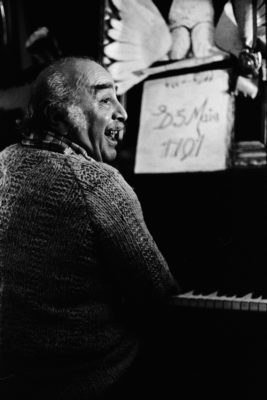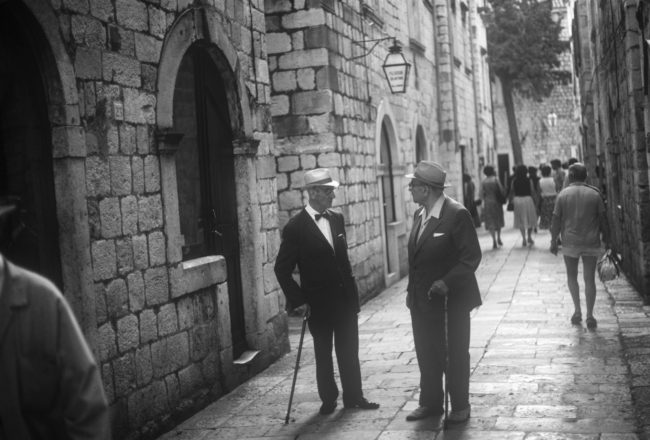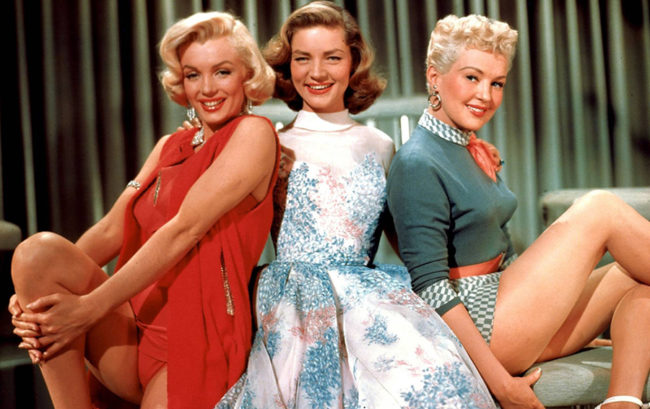MEASURE OF A MAN director Jim Loach and producer Christian Taylor will participate in Q&A’s at the Monica Film Center after the 4:40 and 7:20 PM screenings on Saturday, May 12 and at the Playhouse 7 after the 11 AM and 1:40 PM shows on Sunday, May 13. Co-star Judy Greer will join them for the Sunday Q&A’s.
AMERICAN SOCIALIST: THE LIFE AND TIMES OF EUGENE VICTOR DEBS Filmmaker Yale Strom in Person for Q&A’s at the Monica Film Center and Playhouse.
AMERICAN SOCIALIST filmmaker Yale Strom will participate in Q&A’s on the following schedule: Friday May 4, 7:10 and 9:55pm in Santa Monica; Saturday, May 5 all Santa Monica screenings; Sunday, May 6 at the Playhouse for the 1:50pm show and the 7:10 and 9:55pm shows in Santa Monica.
TWOFER TUESDAY: 65th Anniversary Screenings of Two Marilyn Monroe Classics June 5th in Pasadena, North Hollywood, and West LA
 Laemmle Theatres and the Anniversary Classics series present a tribute to one of the greatest stars in film history, Marilyn Monroe, during her birthday month of June. The program, part of our Twofer Tuesday series, features two of Monroe’s most popular movies—GENTLEMEN PREFER BLONDES and HOW TO MARRY A MILLIONAIRE, both from 1953.
Laemmle Theatres and the Anniversary Classics series present a tribute to one of the greatest stars in film history, Marilyn Monroe, during her birthday month of June. The program, part of our Twofer Tuesday series, features two of Monroe’s most popular movies—GENTLEMEN PREFER BLONDES and HOW TO MARRY A MILLIONAIRE, both from 1953.
 ‘Blondes’ is an adaptation of the 1949 stage musical by Anita Loos and Joseph Fields, based on a 1925 novel by Loos, one of the first women writers to score a success in Hollywood as well as on Broadway. It tells the story of two showgirls and best friends, played by Monroe and fellow screen siren Jane Russell. Marilyn plays the endearing gold-digger, Lorelei Lee.
‘Blondes’ is an adaptation of the 1949 stage musical by Anita Loos and Joseph Fields, based on a 1925 novel by Loos, one of the first women writers to score a success in Hollywood as well as on Broadway. It tells the story of two showgirls and best friends, played by Monroe and fellow screen siren Jane Russell. Marilyn plays the endearing gold-digger, Lorelei Lee.
Master director Howard Hawks, who excelled in several genres, proved just as adept in his first and only screen musical. Charles Lederer, the writer of such films as Hawks’ ‘His Girl Friday’ and ‘I Was a Male War Bride,’ freely adapted the stage play. Hawks retained some of the songs by Jule Styne and Leo Robin, especially the show’s signature number, “Diamonds Are a Girl’s Best Friend,” choreographed by Jack Cole and sizzlingly performed by Monroe in a bright pink dress. But he added new songs by Hoagy Carmichael and Harold Adamson, including a classic campy number (also choreographed by Cole) with muscle-bound athletes around a swimming pool. Monroe and Russell are ably supported by Oscar winner Charles Coburn (as a lecherous diamond magnate), Tommy Noonan and Elliott Reid.
According to Peter Bradshaw of The Guardian, “Marilyn Monroe and Jane Russell make a fantastic double act in Howard Hawks’ sparkling 1953 comedy.” The New Yorker’s Richard Brody wrote, “Jack Cole’s choreography offers some of the most incisively swinging musical numbers ever filmed.” Dave Kehr of The Chicago Reader added, “The opening shot—Russell and Monroe in sequins standing against a screaming red drape—is enough to knock you out of your seat, and the audacity barely lets up from there… a landmark encounter in the battle of the sexes.”
‘How to Marry a Millionaire’ opened later in 1953 and teamed Monroe with two other screen bombshells, Betty Grable (the top pin-up girl of the 1940s), and Lauren Bacall, who seared the screen when she co-starred with her husband-to-be, Humphrey Bogart.
 In this picture three working girls set their sights on snaring a rich tycoon, but their plans go awry when true love enters the picture. Jean Negulesco directed the script by Nunnally Johnson, and the men in their lives are portrayed by Cameron Mitchell, Rory Calhoun, David Wayne, Fred Clark, and screen veteran William Powell. Leonard Maltin hailed the “terrific ensemble work in dandy comedy of three man-hunting females pooling resources to trap eligible bachelors.” ‘Millionaire’ was the second movie shot in 20th Century Fox’s new Cinemascope format, following the studio’s Biblical breakthrough, ‘The Robe.’ It incorporated Alfred Newman’s memorable score, presented in stereoscopic sound.
In this picture three working girls set their sights on snaring a rich tycoon, but their plans go awry when true love enters the picture. Jean Negulesco directed the script by Nunnally Johnson, and the men in their lives are portrayed by Cameron Mitchell, Rory Calhoun, David Wayne, Fred Clark, and screen veteran William Powell. Leonard Maltin hailed the “terrific ensemble work in dandy comedy of three man-hunting females pooling resources to trap eligible bachelors.” ‘Millionaire’ was the second movie shot in 20th Century Fox’s new Cinemascope format, following the studio’s Biblical breakthrough, ‘The Robe.’ It incorporated Alfred Newman’s memorable score, presented in stereoscopic sound.
At the Royal Theatre only, Debra Levine, the editor of the popular online arts journal arts•meme and the author of several articles about choreographer Jack Cole, will introduce the 7 o’clock screening of ‘Gentlemen Prefer Blondes.’
Our Marilyn Monroe double feature screens Tuesday, June 5th at the Royal, NoHo 7, and Playhouse 7.
Click here to buy a ticket to the 7:00pm show of GENTLEMEN PREFER BLONDES with admission to the 9:00pm show of HOW TO MARRY A MILLIONAIRE included. Or, click here to buy a ticket to the 5:00pm show of HOW TO MARRY A MILLIONAIRE with admission to the 7:00pm show of GENTLEMEN PREFER BLONDES included.
Q&A’s with THE HOUSE OF TOMORROW Filmmaker this Weekend in Pasadena and North Hollywood.
THE HOUSE OF TOMORROW writer-director Peter Livolsi will participate in Q&A’s after the 7:20 PM screening at the Playhouse on Friday, 4/27 and after the 7:40 show at the NoHo on Saturday, 4/28.
LIVES WELL LIVED Q&A’s April 20 & 21.
LIVES WELL LIVED filmmaker Sky Bergman will participate in Q&A’s at the Monica Film Center after the 7:30 PM show on Friday, April 20 screening and at the Playhouse 7 after the 5:20 PM show on Saturday, April 21.
ART IN THE ARTHOUSE presents THE STROM PROJECT: FRAGMENT in Pasadena

ART IN THE ARTHOUSE invites you to view our newest exhibit in Pasadena from photographer, musician, and cultural anthropologist Yale Strom. All works in THE STROM PROJECT: FRAGMENT exhibit are for sale and on display until June 14, 2018.
About the exhibit
Forty years ago, musician and cultural anthropologist YALE STROM trekked to Eastern Europe. He came across Jews living in cities, towns and tiny villages, often reminiscent of a pre-war shtetl environment. He bore witness to a dwindled Jewish population with some areas completely devoid of Jewish life. But he also found that a few larger cities were quite populous, and had actually exhibited an increase in numbers.
 On his journey, Strom discovered a rich tapestry, including remnants of Hasidic and Orthodox worlds, Jews who were greatly devoted to communism, and parents who were fervently seeking better lives for their children and their children’s children.This photographic exhibition is a small window into a large field of conditions as they were, as they are, and perhaps as they will remain. Strom seeks out the moment with an artist’s hyperawareness, capturing it with an emotion and tone that is singular and authentic. The artist expresses a quality of relaxed spontaneity in his work, an organic, natural approach that never feels preset. The shots were taken with a 35mm Nikon FE camera using Kodak Tri-X 400 B&W film.
On his journey, Strom discovered a rich tapestry, including remnants of Hasidic and Orthodox worlds, Jews who were greatly devoted to communism, and parents who were fervently seeking better lives for their children and their children’s children.This photographic exhibition is a small window into a large field of conditions as they were, as they are, and perhaps as they will remain. Strom seeks out the moment with an artist’s hyperawareness, capturing it with an emotion and tone that is singular and authentic. The artist expresses a quality of relaxed spontaneity in his work, an organic, natural approach that never feels preset. The shots were taken with a 35mm Nikon FE camera using Kodak Tri-X 400 B&W film.
Strom’s career has been incredibly multi-disciplinary. In the klezmer world, he is celebrated as a leading scholar, ethnographer, virtuoso violinist and bandleader. Remarkably, he is a writer of 12 books, a musician/composer of 15 recordings and a documentarian of 9 films.
His newest film, American Socialist: The Life & Times of Eugene Victor Debs, starts Friday, May 4th in Pasadena and Santa Monica. The film traces the history of American populism with the man who inspired progressive ideas– from FDR’s New Deal to Bernie Sanders’s presidential campaign.
– Joshua Elias, CURATOR

ROGERS PARK Q&A at the Playhouse Opening Weekend.
ROGERS PARK actors Christine Horn (‘American Crime Story’) and Jonny Mars (‘A Ghost Story’) and director Kyle Henry will participate in Q&A’s at the Playhouse after 7:40 PM screenings Friday-Sunday, April 6-8.
THE BATTLE OF ALGIERS 50th Anniversary Screening on Wednesday, April 18 in Encino, Pasadena, and West LA
Laemmle Theatres and the Anniversary Classics Series present the latest in our Anniversary Classics Abroad program, a 50th anniversary screening of Gillo Pontecorvo’s memorable and still timely political drama, THE BATTLE OF ALGIERS.
The film was an Oscar nominee for best foreign language film of 1966, but it was not released in the United States until 1968, when it received additional nominations for best director and for best original screenplay by Pontecorvo and Franco Solinas. The film was considered so inflammatory that it was not shown in France until 1971.
The picture, filmed in black-and-white to approximate the look of a newsreel, dramatizes Algeria’s war of independence against France. It focuses on the years from 1954 to 1957, when the National Liberation Front began to organize in the Casbah of Algiers to carry out terrorist attacks on civilians as well as the French army. This led to a fierce and brutal counter-insurgency by the French, which meant the battles dragged on for years.
To insure authenticity, Pontecorvo cast the film mainly with non-professional actors recruited in Algeria. The film’s one professional actor, Jean Martin, gave a vivid performance as the complex, intelligent French officer who understands the grievances of the Algerians even as he fights ruthlessly to defeat them. The film’s urgency was heightened by the score of Ennio Morricone.
The film’s influence extended well beyond the cinema. It became a sort of handbook of revolutionary techniques that was studied by many radical groups over the years. Yet in 2003, after the invasion of Iraq, the Pentagon also screened the movie in order to better understand the civil war unleashed in that country.
Many prominent filmmakers–including Spike Lee, Mira Nair, Steven Soderbergh, and Oliver Stone–all testified to influence of Pontecorvo’s movie on their own work. Critic David Elliott of the San Diego Union Tribune called The Battle of Algiers “perhaps the finest political film of the 1960s.” The LA Weekly’s Ella Taylor agreed that it was “a classic of politically engaged filmmaking.”
Our 50th anniversary screening of THE BATTLE OF ALGIERS (1968) screens Wednesday, April 18 at 7pm in Encino, Pasadena, and West LA. Click here for tickets.
Format: DCP
- « Previous Page
- 1
- …
- 29
- 30
- 31
- 32
- 33
- …
- 73
- Next Page »



